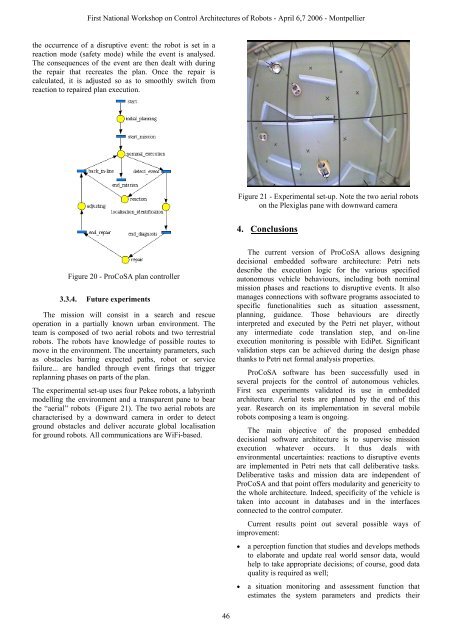Pleading for open modular architectures - Lirmm
Pleading for open modular architectures - Lirmm
Pleading for open modular architectures - Lirmm
You also want an ePaper? Increase the reach of your titles
YUMPU automatically turns print PDFs into web optimized ePapers that Google loves.
First National Workshop on Control Architectures of Robots - April 6,7 2006 - Montpellier<br />
the occurrence of a disruptive event: the robot is set in a<br />
reaction mode (safety mode) while the event is analysed.<br />
The consequences of the event are then dealt with during<br />
the repair that recreates the plan. Once the repair is<br />
calculated, it is adjusted so as to smoothly switch from<br />
reaction to repaired plan execution.<br />
Figure 20 - ProCoSA plan controller<br />
3.3.4. Future experiments<br />
The mission will consist in a search and rescue<br />
operation in a partially known urban environment. The<br />
team is composed of two aerial robots and two terrestrial<br />
robots. The robots have knowledge of possible routes to<br />
move in the environment. The uncertainty parameters, such<br />
as obstacles barring expected paths, robot or service<br />
failure... are handled through event firings that trigger<br />
replanning phases on parts of the plan.<br />
The experimental set-up uses four Pekee robots, a labyrinth<br />
modelling the environment and a transparent pane to bear<br />
the “aerial” robots (Figure 21). The two aerial robots are<br />
characterised by a downward camera in order to detect<br />
ground obstacles and deliver accurate global localisation<br />
<strong>for</strong> ground robots. All communications are WiFi-based.<br />
46<br />
Figure 21 - Experimental set-up. Note the two aerial robots<br />
on the Plexiglas pane with downward camera<br />
4. Conclusions<br />
The current version of ProCoSA allows designing<br />
decisional embedded software architecture: Petri nets<br />
describe the execution logic <strong>for</strong> the various specified<br />
autonomous vehicle behaviours, including both nominal<br />
mission phases and reactions to disruptive events. It also<br />
manages connections with software programs associated to<br />
specific functionalities such as situation assessment,<br />
planning, guidance. Those behaviours are directly<br />
interpreted and executed by the Petri net player, without<br />
any intermediate code translation step, and on-line<br />
execution monitoring is possible with EdiPet. Significant<br />
validation steps can be achieved during the design phase<br />
thanks to Petri net <strong>for</strong>mal analysis properties.<br />
ProCoSA software has been successfully used in<br />
several projects <strong>for</strong> the control of autonomous vehicles.<br />
First sea experiments validated its use in embedded<br />
architecture. Aerial tests are planned by the end of this<br />
year. Research on its implementation in several mobile<br />
robots composing a team is ongoing.<br />
The main objective of the proposed embedded<br />
decisional software architecture is to supervise mission<br />
execution whatever occurs. It thus deals with<br />
environmental uncertainties: reactions to disruptive events<br />
are implemented in Petri nets that call deliberative tasks.<br />
Deliberative tasks and mission data are independent of<br />
ProCoSA and that point offers <strong>modular</strong>ity and genericity to<br />
the whole architecture. Indeed, specificity of the vehicle is<br />
taken into account in databases and in the interfaces<br />
connected to the control computer.<br />
Current results point out several possible ways of<br />
improvement:<br />
• a perception function that studies and develops methods<br />
to elaborate and update real world sensor data, would<br />
help to take appropriate decisions; of course, good data<br />
quality is required as well;<br />
• a situation monitoring and assessment function that<br />
estimates the system parameters and predicts their

















